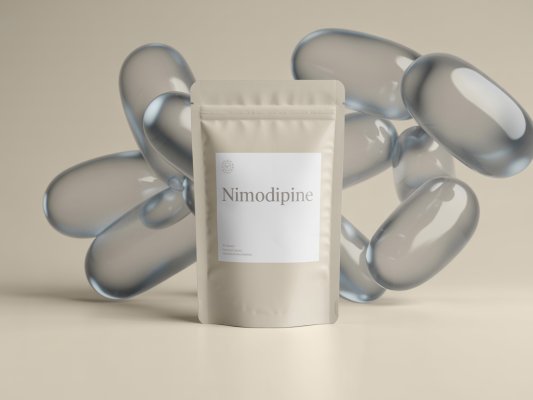
Nimodipine
Description
Nimodipine is a medication primarily used to improve outcomes following a subarachnoid hemorrhage, a type of bleeding in the brain. It belongs to a class of drugs called calcium channel blockers, which help to relax blood vessels. This article provides a comprehensive yet accessible overview of nimodipine, covering its uses, dosage, side effects, and other essential information for both patients and healthcare professionals.
Quick Overview: Nimodipine At-a-Glance
- Key Benefit: Improves neurological outcomes after subarachnoid hemorrhage (SAH).
- Primary Mechanism: Blocks calcium channels, relaxing blood vessels in the brain.
- Best For: Patients recovering from SAH to prevent or treat cerebral vasospasm.
- Typical Dose Range: 60 mg orally every 4 hours for 21 days.
- Key Caution/Consideration: Should never be administered intravenously due to severe risks.
Table of Contents
Categories & Effectiveness
Learn about our rating methodologyBrain Health
Excitotoxicity Defense
7/10Strong evidence of effectiveness
Neuro-Repair Support
7/10Strong evidence of effectiveness
Brain Circulation Boost
4/10Moderate evidence of effectiveness
Cognition
Memory & Recall
4/10Moderate evidence of effectiveness
Mental Acuity
4/10Moderate evidence of effectiveness
working memory
4/10Moderate evidence of effectiveness
Systemic Health
Cellular Repair
7/10Strong evidence of effectiveness
Vascular Health
7/10Strong evidence of effectiveness
Dosage & Side Effects
Recommended Dosage
- Pro Tip: If a patient cannot swallow, nimodipine capsules can be opened, and the contents administered via a nasogastric tube. Flush the tube with saline solution after administration.
Potential Side Effects
Bioavailability & Half-Life
Interactions & Stacks
Recommended Products
Moller’s ® | Lebertran Kapseln | Omega-3-Fettsäuren DHA & EPA, Enthält Vitamin A, D & E, Unterstützt Immunsystem, Herzfunktion, Gehirnfunktion & Sehkraft | 160 Stück
- Rated 4.7 stars by 2,484 customers
- Special offer: 25 % Rabatt auf deine erste Abonnement-Bestellung
Omega 3-400 Kapseln 1+ Jahr Vorrat-1000mg Fischöl pro Tag - Essentielle Omega 3 Fettsäuren mit EPA & DHA - Für Herz, Gehirn & Blutdruck (EFSA) - Natürliches Fisch Öl aus Sardellen - WeightWorld
- Rated 4.6 stars by 1,880 customers
- Premium quality ingredients
Vitamin D3 K2 Hochdosiert 20.000 – 240 Tabletten – VitaminD 20.000 IE – Vitamin D3 K2 Tabletten – Vitamine D3 + K2 Hochdosiert
- Rated 4.6 stars by 132 customers
- Premium quality ingredients
As an Amazon Associate we earn from qualifying purchases. Prices and availability are accurate as of the date/time indicated and are subject to change.
Benefits by Use Case
Cerebral Vasospasm Prevention (post-SAH)
Reduces the risk of delayed cerebral ischemia (DCI) and improves neurological outcomes after subarachnoid hemorrhage by relaxing cerebral blood vessels. Effective when administered within 96 hours of SAH diagnosis.
User Review:
Available evidence demonstrates that nimodipine only reduces the risk for DCI-related death or vegetative state.
Vocal and Facial Motion Recovery (nerve injury)
May promote recovery of vocal fold and facial motion after nerve injury by reducing cellular apoptosis and promoting axonal sprouting. Shows promising results in meta-analyses, but further randomized clinical trials are needed.
User Review:
Existing evidence supports the positive effect of nimodipine on vocal fold and facial motion recovery after injury.
Mechanism of Action
Frequently Asked Questions
Where to Buy Nimodipine
Based on quality, price, and customer reviews, here are our top recommended Nimodipine supplements:
Kollagen Kapseln - 1200mg reines Marine Collagen Typ I und III - Hydrolysierte Fischkollagen Peptide - 120 Kapseln für 2 Monate Vorrat - Alternative zu Pulver - WeightWorld
- Rated 4.4 stars by 10,710 customers
- Premium quality ingredients
Vitamin B Komplex – 240 Tabletten – mit 8 essenziellen B-Vitaminen & Kofaktoren – mit Bioaktiv-Formen – vegan, hochdosiert – laborgeprüft
- Rated 4.6 stars by 8,768 customers
- Premium quality ingredients
Health & Her Perimenopause - mit 800mg Rotklee, 500mg Yamswurzel, Eisen, Vitamin D3, B6 und B12, Maca-Extrakt für eine bessere Hormonbalance in den frühen Wechseljahren - Menopause 60 Kapseln
- Rated 4.3 stars by 2,689 customers
- Premium quality ingredients
As an Amazon Associate we earn from qualifying purchases. Prices and availability are accurate as of the date/time indicated and are subject to change.
Summary & Expert Opinion
Beyond its primary use in aSAH, nimodipine has been explored for other potential applications, such as nerve injury recovery and cognitive enhancement, although the evidence is less robust. Future research may reveal further benefits, but for now, its role in aSAH management remains paramount.
From a technical perspective, nimodipine's action as a calcium channel blocker is relatively straightforward. It selectively inhibits L-type calcium channels, which are abundant in cerebral blood vessels. By reducing calcium influx into smooth muscle cells, nimodipine promotes vasodilation, thereby improving cerebral blood flow. However, the precise mechanisms underlying its neuroprotective effects in aSAH are likely more complex and may involve mitigating spreading depolarization, reducing cerebral edema, and influencing cerebral metabolism.
The pharmacokinetics of nimodipine are also important to consider. Its relatively low bioavailability due to first-pass metabolism necessitates frequent dosing to maintain therapeutic levels. Furthermore, its metabolism by CYP3A4 means that drug interactions are a significant concern. Clinicians need to be aware of potential interactions with CYP3A4 inhibitors and inducers, as these can significantly alter nimodipine levels and affect its efficacy and safety.
The influence of pharmacogenomics on nimodipine response is an area of growing interest. Polymorphisms in genes such as CYP3A5, MDR1, and CACNA1C have been shown to affect nimodipine disposition and clinical outcomes. While pharmacogenomic testing is not yet routine in clinical practice, it may become more important in the future as we strive to personalize nimodipine therapy and optimize outcomes for individual patients.
In conclusion, while nimodipine is a valuable tool in the management of aSAH, it's crucial to use it judiciously and with a thorough understanding of its pharmacology, potential side effects, and drug interactions. Healthcare providers need to be vigilant in monitoring patients for hypotension and other adverse events and be prepared to adjust the dosage as needed. Furthermore, ongoing research is needed to explore the full potential of nimodipine and to identify strategies to optimize its use in clinical practice.










